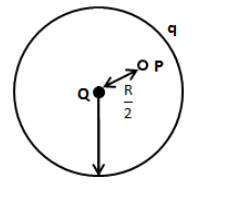Question
Question: A spherical conducting shell of radius R has a charge q. A point charge Q is placed at its centre....
A spherical conducting shell of radius R has a charge q. A point charge Q is placed
at its centre. The electrostatic potential at a point P a distance 2R from
the centre of the shell is:
A. 4πε0(q+Q)R2
B. 4πε0R2Q
C. 4πε0R2Q−4πε0Rq
D. 4πε0R2Q+4πε0Rq
Solution
The potential at point P at a distance r from the point charge inversely proportional to the distance between the point P and charge q. The potential inside the charged conducting shell remains the same at every point. The potential at point P will be the contribution of potential due to charge placed at the centre of the sphere and the charge distribution on the outer conducting shell.
Formula used:
The potential due to point charge at a distance r is,
V=4πε01rQ
Here, ε0 is the permittivity of the free space and Q is the charge.
Complete step by step answer:
Let’s draw the situation given in the question as shown in the figure below.

We have the expression for the potential due to point charge at a distance r from the charge
is,
V1=4πε01rQ
We have given that the position of point P is 2R from the centre of the
shell. Therefore, substituting 2R for r in the above equation, we get,
V1=4πε01R2Q……. (1)
We have the expression for the potential inside the charged conducting shell of radius R is,
V=4πε01Rq
Here, q is the charge on the sphere.
This potential remains the same at every point inside the sphere. Therefore, the potential at
point P inside the sphere due to charge on the sphere is,
V2=4πε01Rq ……(2)
Thus, the potential at point P will the sum of the potential due to point charge Q and
potential inside the charged sphere. Therefore, we can write,
V=V1+V2
